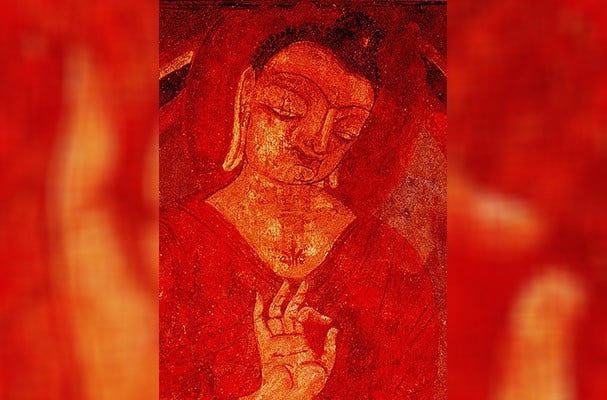This article first appeared in the Effective Evangelism column of the CHRISTIAN RESEARCH JOURNAL, volume 25, number 04 (2003). The full text of this article in PDF format can be obtained by clicking here. For further information about the CHRISTIAN RESEARCH JOURNAL go to: http://www.equip.org/christian-research-journal/
Popular and prolific Buddhist author Thich Nhat Hanh reports in his book, Living Buddha, Living Christ, that his “personal shrine” contains images of both Buddha and Jesus, whom he deems spiritual brothers, both worthy of veneration. Given the current popularity of the Dalai Lama and books and magazines on Buddhist meditation and practice, it seems many Americans might also hold Hahn’s perspective. Those caught in the strong winds of religious toleration and relativism shrink from logically judging the truth claims of these great religious founders. Instead, people often assume that they were equally significant “spiritual teachers” who taught roughly the same thing. Accepting both Jesus and Buddha as enlightened beings is taken to be nonjudgmental, inclusive, and affirming of both Christians and Buddhists. Why bother considering one teacher above the other — especially in our contemporary pluralistic culture? How should Christians, who worship Jesus alone, respond to this pervasive notion that Jesus and Buddha were great spiritual masters on the same plane?
The essential religious truth claims of Jesus and Buddha differ radically from one another. To think otherwise is to ignore history, logic, and the well-being of one’s soul, since Jesus and Buddha proposed radically different spiritual paths. Jesus, in fact, warned that the path to life was narrow and that many fail to find it (Matt. 7:13). Jesus’ followers must not shrink back from the seriousness of His statement, especially in our pluralistic society.
Before comparing the basic teachings of Jesus and Buddha regarding God, humans, and salvation, one should point out to those enamored of the Buddha that the earliest written documents about the life of Buddha (563–483 b.c.) come about five hundred years after his death. In his edited collection, Buddhist Scriptures, Edward Conze notes that Buddhism has nothing that corresponds to the Christian New Testament, which is an authoritative canon of Scriptures written a short time after the life of Jesus.1 Let no one, therefore, take Buddhist records as hard history and then discount the New Testament for being too ancient to be historically credible.2
Two Virgin Birth Stories. Some try to narrow the gap between Jesus and Buddha by saying that both are recorded as having come into the world through spiritual means via a virgin birth. In their recent book, The Original Jesus, Elman Gruber and Holger Kersten go even further and argue that the story of Jesus’ virgin birth was borrowed from a Buddhist source that claimed the same kind of supernatural origin for Buddha.3 This is unlikely. First, this view overlooks significant differences between the two accounts. In the Buddhist account, the prehuman Buddha came in the form of a white elephant who entered the side of his mother. Religious scholar Geoffrey Parrinder notes that it “was not a virgin birth, since she was married, and in this story…it is celestial influence rather than a divine seed that enters her.”4 The Gospel’s account of Jesus’ conception and birth differs radically (Luke 1:26–35).
Second, the Buddhist sources are dated long after the gospels of Luke and Matthew. The Buddhist story comes from a fifth-century a.d. text and is absent from the most ancient Pali canon of Buddhism.5 If any borrowing occurred, it is more likely that Buddhists selectively borrowed from the Gospels than vice versa.6 The New Testament documents were all written in the middle to the late first century. According to renowned biblical scholar J. Gresham Machen, the virgin birth material had “been in existence only a few decades from the time when Jesus lived.”7 This is quite different from the late emergence of the Buddhist stories.
What about Jesus’ and Buddha’s essential worldviews, that is, their teachings on ultimate reality, the human condition, and spiritual liberation?
Two Views of Ultimate Reality. Jesus affirmed the existence and unity of a personal and moral God, who is both sovereign over history and involved with it. He taught His disciples to pray, “Our Father who is in heaven” (Matt. 6:9 nasb). Jesus never challenged the monotheism of His Jewish brethren but affirmed it and intensified its spiritual and moral challenges (Matt. 5–7).
Buddha, however, did not deem theological matters worthy of consideration. He regarded them as metaphysical speculations, unedifying and irrelevant to attaining spiritual liberation. He challenged key features of the Brahmanism of his native India but did not embrace belief in a Creator God as fundamental to proper spirituality. Buddha’s image is worshiped around the globe, but he never considered himself a revelation of God. He rather considered himself an enlightened teacher (“Buddha” is a title that means “the enlightened one”).
Two Views of the Human Condition. Human beings, according to Jesus, were created by God (Matt. 19:4) and ought to worship and obey God with their whole beings, as well as to love their neighbors as themselves (Matt. 22:37–39). Jesus taught that humans possess immaterial souls that persist after death and that will one day be reunited with resurrected bodies (Matt. 12:26–27; John 5:28–29). Jesus, however, also referred to humans as spiritually “lost” (Luke 19:10) and corrupt at their core (Matt. 9:13; Mark 7:21–23).
Buddha did not speculate about human origins but focused on the human condition as (1) suffused with suffering (2) brought about through unfulfilled desires (the first two of the Four Noble Truths, the essence of Buddhism). He taught that people cannot satisfy their souls with anything because they do not have souls. Just as a chariot has no essence, but is only a collection of individual parts, so the human person has no essence or substance; it is only a collection of parts or states called skandas. There is no personal essence or soul, and there is no personal afterlife. Buddha did not deny the Hindu doctrines of transmigration and reincarnation, but he denied that there is any individual soul that comes back in another form.
Two Views of Spiritual Liberation. According to Jesus, salvation is found in Him alone: “The Son of Man came to seek and to save what was lost” (Luke 19:10 niv). Jesus viewed Himself as the only way to restore fellowship with the heavenly Father: “All things have been committed to me by my Father. No one knows the Son except the Father, and no one knows the Father except the Son and those to whom the Son chooses to reveal him” (Matt. 11:27 niv; cf. John 14:6). He claimed, moreover, to be God incarnate (John 8:58). In light of this, Jesus beckons us to follow Him (Matt. 11:28–30) and to believe in Him for the forgiveness of sins and eternal life (John 3:16; 6:29). These claims, however, were not uttered in a vacuum. Jesus demonstrated Himself to be the divine Messiah through the wisdom of His teaching, His fulfillment of Hebrew prophecy, the unparalleled power of His miracles, His authority over the demonic world, His sacrificial death on the cross, and His own death-shattering resurrection.8
Buddha taught that spiritual deliverance was found by letting go of desire and the quest to satisfy the nonexistent soul, and by detaching oneself from impermanent things. This teaching is the Third Noble Truth. The Fourth Noble Truth is that salvation is achieved through effort, which Buddha called “the eightfold path.” It requires wisdom (right understanding and thought), ethical conduct (right speech, action, and livelihood), and mental discipline (right effort, awareness, and meditation). Those who succeed leave the realm of karma and rebirth and attain nirvana, which is the blowing out of the human personality in a state that supposedly cannot be described in words. Buddha did not claim to bestow this state upon others, he simply pointed toward it. He never claimed to be God moreover; nor did he raise the dead, heal the sick, or cast out demons. At age 80, he died.
According to the New Testament, Jesus came into the world as a supernatural agent of redemption, who accepted suffering at the hands of sinful humans that He might vicariously atone for the sins of a rebellious world estranged from its own Source of goodness and life. He embraced suffering on the cross in order to rescue those suffering from sin and its effects (Isa. 53). As one poet wrote, “No other God has wounds but thee.” The risen Jesus presented His wounds to doubting Thomas as proof of the efficacy of His mission (John 20:26–29).
The oldest accounts of the life of Buddha do not depict him as a supernatural figure but as an illuminated sage. Images of Buddha worldwide show a man sitting in tranquil contemplation with his eyes shut to a world he wants to transcend. How different from this posture was the defining act of Jesus, who, though nailed to a cross, bruised and bloodied, gazed in love on the world He came to redeem. Buddha taught the dharma (the way or teaching) to many others, but he never claimed to overcome death through his own death or to offer life through his own life. He only pointed the way to nirvana whereas Jesus opened the door to heaven.
The essential teachings and ministries of Jesus and Buddha cannot be reconciled or synthesized. No amount of religious tolerance or pluralism can erase the deep and sharp differences between these two identities, their worldviews, and their actions. By accurately defining these differences we do justice to both religious leaders while communicating the truth in love to those who would place them on the same plane.
— Douglas R. Groothuis
NOTES
- Edward Conze, “Introduction,” in Buddhist Scriptures, ed. Edward Conze (New York: Penguin Books, 1959), 11–12.
- On the reliability of the New Testament, see Douglas Groothuis, Jesus in an Age of Controversy (Eugene, OR: Wipf and Stock, 2002), chaps. 2–3.
- Elmar R. Gruber and Holger Kersten, The Original Jesus: The Buddhist Sources of Christianity (Rockport, MA: Element Books, 1995), 82–83.
- Geoffrey Parrinder, Avatar and Incarnation (New York: Barnes and Noble, 1970), 135.
- See J. Gresham Machen, The Virgin Birth of Christ (New York: Harper and Brothers, 1930), 339.
- Ibid., 340.
- Ibid., 342.
- On the claims and credentials of Jesus, see Groothuis, Jesus in an Age of Controversy , chaps. 13-16; and Douglas Groothuis, On Jesus (Belmont, CA: Wadsworth/Thomson Learning, 2003), chap. 8.









